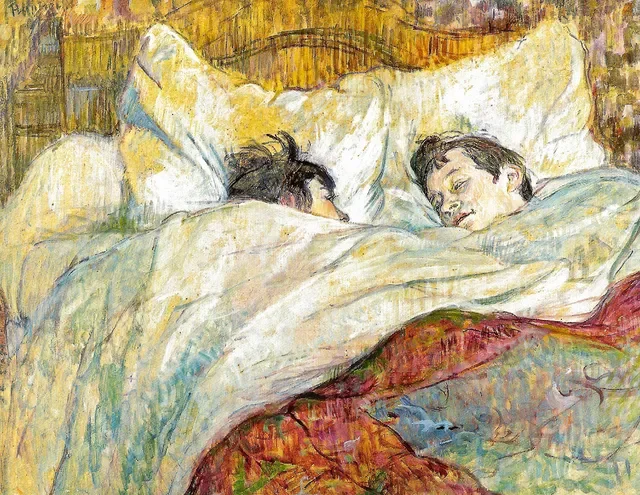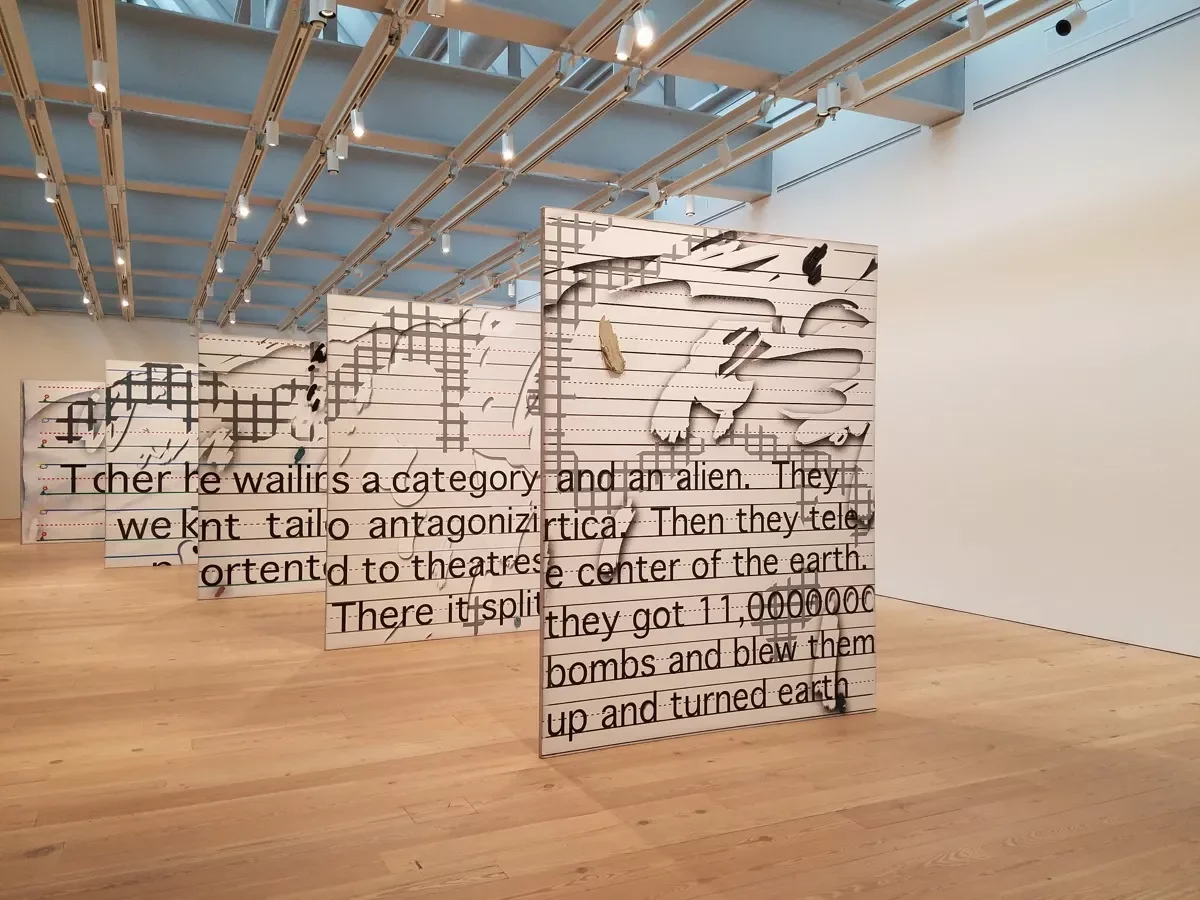Untitled (2000), Laura Owens
Acrylic, oil, and graphite on canvas, 183 × 169 cm
Whitney Museum of American Art, New York
Two figures lie side by side beneath a floral quilt, heads resting on pillows, eyes meeting in a still yet charged exchange. The colors around them dissolve into airy blue fields. The bed they share hovers without gravity, like memory. This is Untitled (2000) by Laura Owens, a work which marks a rare foray into depicting human figures. In this work, we have permission to witness a feeling: a moment of proximity rendered without plot, an image of what it means to see and be seen.
Owens appropriates from all spheres — advertisements, pop culture, her son’s homework, and, of course, artists. This composition borrows directly from Henri de Toulouse-Lautrec’s Le Lit (c. 1892), a painting in which two women lie beneath white sheets, exchanging a gaze that is intimate, tired, and unforced. Lautrec's painting, while set in a brothel, refuses voyeurism. It was praised even in its own time for its tenderness, for portraying women, historically assumed to be lesbians, with sensitivity and without spectacle. Owens echoes that quiet humanity, but rather than the warm golden palette of Lautrec, she wraps her scene in deep cobalt and pale azure. Blue, in her hands, feels tender. It hushes the canvas. It carries the bed.
Le Lit, Henri Toulouse-Lautrec
Oil paints on cardboard, mounted on wood, 53.5 by 70 cm
Musée D’Orsay, Paris
Owens works with acrylic and oil on linen, combining digital printing and painterly gestures. The floral quilt that covers the two figures is borrowed from one of her earlier paintings. In this context, it feels like a layer—an accumulation of past works repurposed as a shelter. The blue background isn’t a wall or a room; it’s an emotional register. The figures don’t lie in a physical space so much as drift in the stretch between thought and sensation. It brings to mind the way you might reach out and touch your lover’s skin with only a mild subconscious thought or the way they might caress you absentmindedly in the name of love.
There is a word in Japanese—mesen kōkan—which means "exchange of gazes." In French, the phrase regard partagé means "shared look." Both imply a kind of communion: two beings suspended. That is what Owens captures here. The eyes of the figures meet without drama. They are not performing. They are holding each other in place.
The quiet of this image is not emptiness. It’s a kind of fullness that refuses noise. In painting a moment so small—a bed, a glance, a wash of blue—Owens reminds us what art can do when it listens more than it speaks. The shared gaze becomes a site of recognition. And in that recognition, we are made to feel not just what closeness looks like, but what it feels like: ordinary, necessary, deeply alive.
Installation view of Laura Owens, Untitled, 2015
Whitney Museum of American Art, 2017
In 2017, the Whitney Museum of American Art staged a mid-career retrospective of Owens’s work, where Untitled (2000) was included — as it happens, most of her works are titled Untitled. The exhibition catalogue, rich with documentation and essays, was presented with unique hand silk screen printed covers made in Owen’s studio in Los Angeles.
Owens has continued to explore relational space—sometimes through abstraction, sometimes through layering, always with attention to how material and emotion can occupy the same field. She brings humour and movement to her work, and this painting feels like an outlier — quieter, more distilled — amid the bold, offbeat genius vibe that dominates her victorious Whitney retrospective. The retrospective as a whole feels like being filtered through a black-market synthetic drug dream — something between fever and fantasy, like a tale born from the mind of Lewis Carroll.
Installation view of Laura Owens, Untitled, 2015
Whitney Museum of American Art, 2017
While the colour and excitement of her other works might take center stage, maybe paintings like this matter because they refuse the spectacle. They draw us inward, asking us not to look harder but to look longer. To sit with the softness. To let the blue unfold. To recognize, in a shared gaze, the quiet revolution of being present with another.



